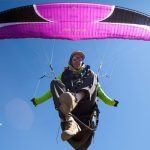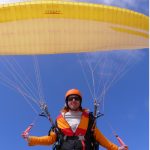Air turbulence and paragliding
Certain phenomena such as turbulence can make a paragliding flight uncomfortable and dangerous. You should be comforted by the fact that during your paragliding training you'll be flying under calm conditions and on familiar sites, all the time accompanied by experienced paragliding instructors. Nevertheless, recognizing and understanding these hazards is the first step towards knowing how to avoid them.
Let's begin by looking at turbulence. Turbulence comes from the chaotic movement of air within an air mass. They can be divided in two main types: obstacle turbulence and shear turbulence.
Obstacle turbulence and dangers for paragliders
Let's first look at obstacle turbulence. When the wind blows over an obstacle, unevenly and discontinuously turbulence forms. Air constantly flows up to the top of the windward side of this landform, but as soon as the air passes over to the leeward side a depression forms, generating turbulence, which is called rollers and rotors.
They may also be areas of the windward side where turbulence occurs, for instance if the windward side is hilly or irregular, turbulence will form in the immediate vicinity of the obstacle.
Of course, in some cases, the obstacle generates no turbulence at all, either on the windward side nor leeward side such as the case of a platform, creates a dynamic lift. Similarly, the airflow on the leeward side of obstacles such as a hedge of trees or house can also be turbulent.
For this reason landing downwind of such obstacles is not recommended for paragliders.
Shear turbulence: the spice of thermal flying
Let's now turn to the other type of turbulence, shear turbulence. Shear turbulence occurs
where two air masses move against one another. This is the case around the thermal lift since warm air rises in the centre and cooler air descends around it. When you fly your into a thermal you will feel the effects of this shear turbulence on your paraglider.
Another example of shear turbulence you're likely to encounter when flying is the case of two superimposed air layers that are moving in opposite directions. Shear turbulence
is present along the border, separating the two layers.
The venturi effect
When a fluid such as wind passes through a narrow or restricted passage along its trajectory its speed increases. This is known as the venturi effect.
Let's use the example of wind blowing over a hill. At Point A the lower and upper winds are travelling at the same speed at point B. The lower we descend into the airmass to faster the
wind speed is. Notice that the wind closest to the hill is the fastest. In fact the wind is being compressed between the hill and the weight of the atmosphere. At Point C near the top of the hill, the speed is the highest because the atmospheric weight forces the wind through a narrow passageway. So, as to ensure a constant flux the wind is forced to catch up by accelerating.
We also see the venturi effect occur when wind travels through a mountain path. As the wind blows through the path the airstream will be compressed like the wind blowing alongside the hill it will also speed up as it makes its way through the narrow passageway.
The wind gradient and the dangers for paragliders
The wind gradient is the variation of wind speeds at different altitudes. This phenomenon
is present at any altitude in our atmosphere but wind gradient we are interested in is the one where wind speeds decrease at low altitudes. Close to the ground, during our landings that is at altitudes less than 50 meters from the ground why does the wind speed slow down.
The air is a fluid with a certain viscosity that sticks to obstacles, so it loses a lot of its energy. The further we descend, the slower the winds will blow because of the gradient effect. This effect is present on fields full of obstacles such as hedges, but be careful it may also be present on flat obstacle-free fields.
During landing procedures, the pilot must be extremely vigilant when dealing with the wind gradient; as soon as the wing encounters the gradient it will lose relative airspeed. The only way to make up for the loss bee-eaters to lose altitude: the wing will accelerate by itself and in some cases, it will roll-off.
Maintaining a sufficient amount of speed during the final approach is recommended to deal with this effect and a thang that can be dangerous close to the ground; make a note of the fact that the altitude loss is directly proportional to the gradient intensity.
This post is a transcription of the video "Learn to Fly" (Kitchen Productions)















